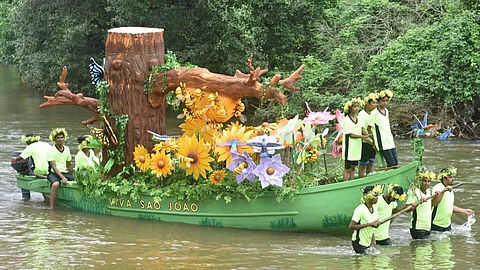

In Goa, the month of June is as much about the arrival of the monsoons as it is about a festival that celebrates the bounty that the rains bring. Yes, we’re referring to the feast of Sao Joao (feast of St John the Baptist), being celebrated today, June 24, across Goa – with the unique tradition of jumping into wells.
According to the Bible, St John the Baptist leaped with joy in the womb of his mother, Elizabeth, when her cousin, Mary, mother of Jesus, visited her. The Sao Joao tradition of jumping into wells symbolises the joyous leap of St John the Baptist and commemorates that biblical moment.
Sao Joao holds a special significance for sons-in-law in Goa. Traditionally, a newly married son-in-law is crowned with a festive kopel — a floral headgear adorned with vibrant flowers, leaves and even fruits.
He is also honoured with a lavish spread of seasonal fruits, which is why the celebration is sometimes referred to as the javyache fest (festival of the son-in-law).
One of the highlights of Sao Joao is the kopel. These beautiful floral crowns are made using colourful leaves, seasonal blooms, and a key ingredient — a creeper locally known as sanjuachi vaal, or satavari (Asparagus racemosus).
Commonly found in backyards at this time of year, the plant is used to frame the kopel, often alongside coconut palm fronds.
Ayurvedic practitioner, Dr Maryanne Lobo says, “This plant is medicinal and supports uterine health, boosts lactation in nursing mothers, and helps regulate menstrual cycles.”
She adds that due to these qualities this creeper is also considered a sign of fertility, which is probably why it is also a part of this feast and is associated with young married couples.
This plant is medicinal and supports uterine health, boosts lactation in nursing mothers, and helps regulate menstrual cycles
Dr Maryanne Lobo, Ayurvedic practitioner
Asparagus racemosus is a graceful woody climber that grows up to 1–2 meters tall. It features fine, pine-like leaves and delicate, white flowers.
“In the hot summer, this creeper remains dormant due to its tuberous roots and springs back to life with the onset of the monsoons, which is why it appears during this time of year,” adds Lobo.
The kopel is made of seasonal plants, leaves and flowers and even berries, such as ‘apple cherry’ (Carissa carandas). These are pretty, red-coloured berries which are seen at this time of the year.
Agriculture expert, Miguel Braganza informs, “The apple cherry is an ornamental variant of the karvandam (the berries which we eat during summers in Goa). These are candied and then used as cherries in cakes, pastries and fruit salad.”
These berries are a seasonal delicacy and are, thus, a part of our local festivals.
All these festive customs and rituals remind us of our close bond with the environment. Incorporating them into our celebrations not only honours tradition, but also helps promote ecological awareness. And, on that note, Viva Sao Joao!